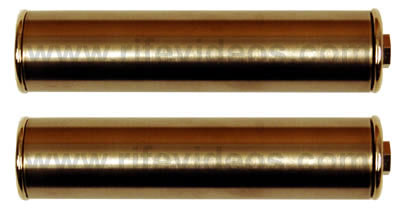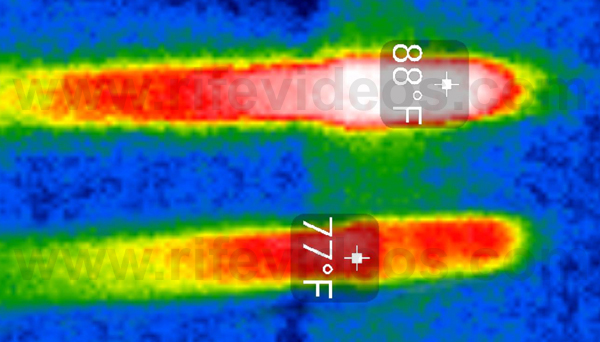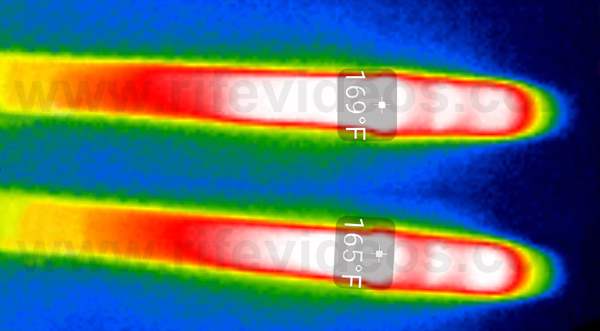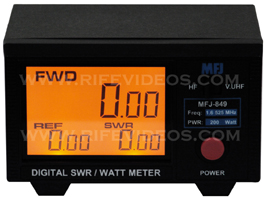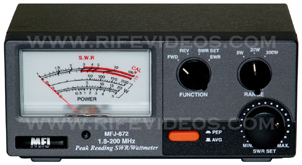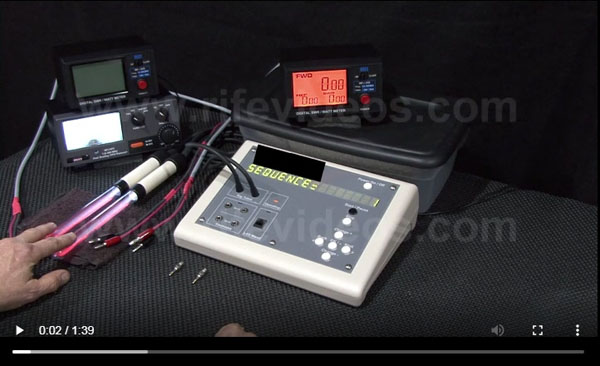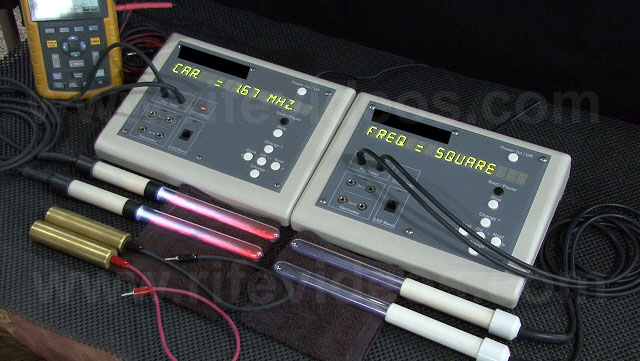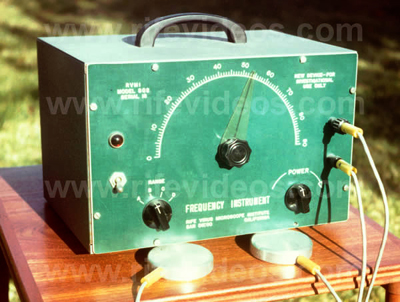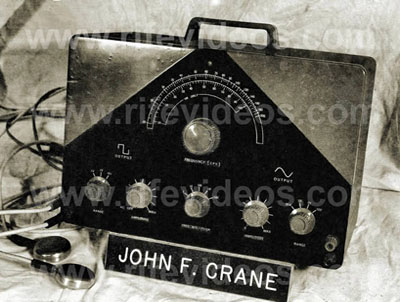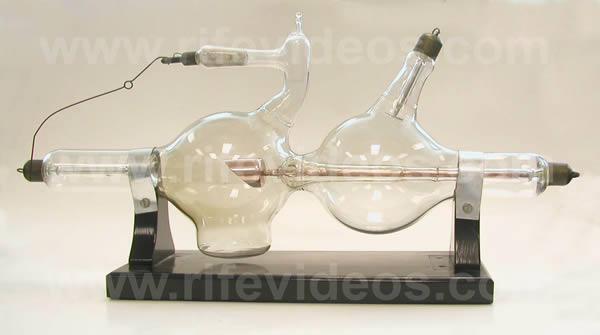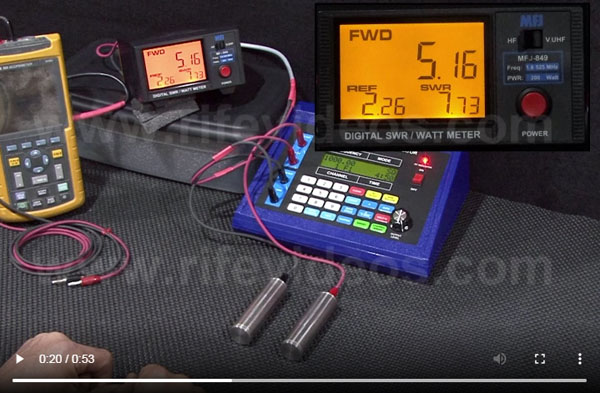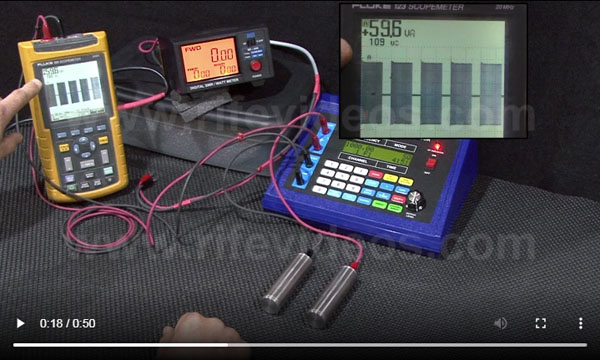| Home | Accessory Kit | Marsh CD Collection | Library | Contact Us |
Metal Hand-Cylinders
or
Hand-Held Ray Tubes
What you Really want to Know!
In Chapter 20 of this report, we have scientifically shown how "Spooky Action at a Distance" which includes "Distance Healing" does not work as claimed because "Quantum Entanglement" is only a ONE TIME, ONE DIRECTION communication, not a bi-directional communication, that cannot carry any frequency information. In chapter 21 of this report, we have scientifically shown how the "Piezoelectric Crystal Filled Glass Hand-Cylinders" have fatal design flaws that keep them from being able to produce any ultrasound frequencies as claimed. In this Chapter we will scientifically show, using Wattmeter measurements, how small "Hand-Held Ray Tubes" cannot output the power levels claimed.
Most people do not understand there is a significant difference between using "Metal Hand-Cylinders" and small "Hand-Held Ray Tubes. In Chapter 17 of this report, we scientifically showed how the "Skin Effect" of a metal conductor does not apply to human tissue. In Chapter 18 we scientifically showed how "Conduction" or the contact method (metal hand-cylinders) and "Induction" or the non-contact method (plasma ray tubes) work on different scientific principles. In those chapters, we scientifically showed that metal is a superior conductor of electrical current when compared to glass. If you have not read those chapters we suggest that you read them so you will better understand this chapter. Below are photos of two different styles of hand-held glass ray tubes and metal hand-cylinders.
It is important to understand that Dr. Rife never use metal hand-cylinders or hand-held ray tubes. Other people developed these two methods and we will discuss this later. Now let’s consider the concept of holding two small hand-held glass ray tubes. We use the word small because they have about 30 times less volume of plasma gas in them when compared to the larger ray tubes that Dr. Rife used. All ray tubes whether they are the single type used by Dr. Rife or the double type, such as small hand-held ray tubes, can work on the contact and non-contact method. The single ray tube method used by Dr. Rife can work on both methods but at a different percentage ratio. Dr. Rife's single ray tube was not meant to be held in the hands, but if you do hold it in your hands about 3% to 7% of the energy will be transferred through direct contact to you or the person holding the single ray tube. This is a measurable voltage drop using an oscilloscope. In order to increase it to 7%, a grounding mat must be used. Because small hand-held glass ray tubes alternate the electrical current or power back and forth between the two ray tubes this reversing of the polarity creates a strong magnetic field between the two hand-held ray tubes which changes the power percentages to about 47% through "Conduction" or direct contact and about 53% through "Induction" or the non-contact method.
This reversing of the polarity or electrical current back and forth between the hand-held ray tubes is no different than using metal hand-cylinders with AC or alternating current. Because the current is alternating back and forth between the two metal hand-cylinders the power or voltage and current go into the body of the user. Where the big difference is, metal hand-cylinders work 100% on "Conduction" or direct contact with the skin and 0% through "Induction" or the non-contact method. This is easy to understand since the only way you can be electrocuted is if you actually touch a metal conductor or wire.
We mentioned earlier in this chapter that Dr. Rife never developed or used hand-held ray tubes. It was Ed Skilling back in the early 1980s that developed the first hand-held ray tubes. He stated that his hand-held ray tube circuit only output about 2-watts. This was back when no frequency generators were using an RF carrier frequency and they were limited to only low audio frequencies which can be felt by the user. Because of this limitation, power levels were limited with audio frequencies to no more than 1/10th to 1/20th of 1-watt. This meant that Ed Skilling's 2-watt hand-held ray tube instrument was 10 times more powerful than any other instrument, even with the 53% loss due to the fact that glass is both a dielectric and an insulator. Chapter 18 of this report covers this dielectric information. Today RF carrier frequencies are used which allows up to about 20 watts of power to be used with the metal hand-cylinder method.
Ed Skilling found that his small hand-held ray tube's power output was limited because of the plasma tube gas volume. Some claim that their hand-held ray tubes are able to output 30 watts or more power, but this is scientifically impossible because they will become too hot for the user to hold in their hands. To demonstrate this fact a pair of these hand-held ray tubes were connected to a variable 3-watt to 200-watt plasma tube circuit. That circuit was set at 30-watts output measured with an MFJ-849 digital readout wattmeter. Before and after infrared photos were taken so the temperature could be read.
The first infrared photo, shown below, shows the hand-held ray tubes after 5 minutes of their instrument running at full power with every setting at maximum output. Notice the highest temperature of their two plasma tubes is only 88 degrees.
The next infrared photo, shown below, is with a 3-watt to 200-watt adjustable instrument set at a 30-watt output. It shows the temperature of their hand-held ray tubes after only about 40 seconds with a true 30-watts of power put into them with a 90% square wave duty cycle. Notice the hand-held ray tube with the highest temperature is 169 degrees and the other one is 165 degrees. This is too hot for anyone to hold in their bare hands.
These infrared photos speak for themselves and show the instrument power level of 30-watts or more output is not correct. The two hand-held plasma tubes will become hotter if they are run longer, but we did not want to damage the ray tubes.
Because of this infrared test and the results, it was apparent the 30-watts or more power output is incorrect. So a video wattmeter test was made to see what the real power output of the hand-held ray tube circuit was. A wattmeter is the most accurate method to use when doing a power test. The MFJ-849 digital readout wattmeter and MFJ-872 needle style wattmeter, shown below, were used in the test of the hand-held ray tube circuit. The MFJ-849 digital readout wattmeter is capable of measuring power levels as low as 0.05 watts, even though MFJ only gives a minimum of a 1-watt power level in their technical paperwork. So these instruments are more accurate than stated at +/-5%.
The MFJ-849 digital readout wattmeter test did not register any power output. This revealed the power output level of this hand-held ray tube circuit is less than 0.05-watts with +/- 5%, not the 30-watts or more power output level listed for the circuit. We did not expect the power level to be less than several watts. To verify this test we then again tested the circuit with the MFJ-872 needle style wattmeter and you will see it would only move the needle slightly above 0-watts. This confirmed the less than 0.05-watts output power was correct. Both wattmeters verify the power level measurement of less than 0.05-watts was accurate. Later in this chapter, you will see other video tests that show how well these wattmeters work in measuring power output. For this test, the square wave duty-cycle setting of the hand-held ray tube instrument circuit was put at maximum output. A plasma tube gas is very easy to light when using high voltage and this is why they are able to light the hand-held ray tubes with only about 0.04 watts. Click on the photo below to watch the wattmeter test video.
If you watched the video then you were able to see that the wattmeters did not measure the 30-watts output from the hand-held ray tube circuit. In fact, the circuit outputs less than 0.05 or 1/20th of 1-watt. This low power output is the reason the infrared temperature photo above of the hand-held ray tubes only shows 77 degrees and 88 degrees. How they measured the power output of this hand-held ray tube circuit at 30-watts we do not know. It certainly was not done with any wattmeters that would give an accurate power measurement. We tested a second hand-held ray tube instrument to verify our measurements and found they were correct. Below is a photo of that second test.
Another problem with small hand-held ray tubes is they are made of glass which is both a dielectric and an insulator. The power loss through glass is about 53% through "Conduction" or the contact method. This fact means if you only have 0.04-watts power output then the user will only receive about 0.02-watts of that 0.04-watts. This is the reason why metal hand-cylinders work better because they will deliver almost 100% of the power output of a circuit through "Conduction" or the contact method. People want the maximum amount of power for the best results, not the least amount. Hand-held ray tubes are not any better than the "Crystal filled glass hand-cylinders." Both of these methods only deliver a fraction of the amount of power to the user instead of almost 100% as with metal hand-cylinders.
As mentioned before, Dr. Rife only used a single ray tube which was at least 6 inches in diameter or larger. It was Dr. Rife's two business partners, John Crane, and John Marsh, who made and used the first metal style electrodes for use with frequency generators. They were called contact "Pad" instruments. In the two photos below you can see the first round metal disk style electrodes they used. Later people replaced the round metal disks with metal hand-cylinders which are easier to hold in your hands. They also made and used metal footplates.
Dr. Rife did not even like metal disks for delivering the frequencies. Not because this method did not work, but because of the limited power that could be delivered using only low audio frequencies without an RF carrier frequency. John Crane and John Marsh recognized this low power drawback and found this method only worked on small areas of the body. Dr. Rife's plasma ray tube instruments used an RF or radio frequency carrier with low audio frequencies. His ray tube could also output higher RF frequencies. The higher RF frequencies were mixed with the RF carrier frequency and output through the ray tube. His 1934 Rife Ray #3 was a 50-watt instrument and the Rife Ray #5, which was the only instrument sold to doctors and the public in 1938 and 1939 was a 75-watt instrument. The 1950s version of this instrument output 50-watts but was capable of 75 to 150-watts.
As mentioned before, John Crane and John Marsh did not use an RF carrier frequency with their metal disk or metal hand-cylinder instruments. Because of this they were limited to about 1/10th (0.10) to 1/20th (0.20) of 1-watt power output. Most people can only handle about 1/10th (0.10) of 1-watt. Even today these very low power levels are still being used by many so-called "Rife Machine" manufacturers with the same limited power level and the same limited results. Here is Dr. Rife's statement taken from his attorney's 1970's interview which clearly shows he did not approve of this very low power level. Bertrand Comparet was his attorney in both the 1930s and 1950s. This statement was taken from a 1970's interview of Bertrand Comparet. We quote:
COMPARET: “And I asked Rife, because I thought Rife would certainly say that the way Crane was working on it then [metal disks] was still using the Rife principle, but he indignantly denied it.”
HUBBARD: "All right, I see. But, getting back, you say that Rife was very indignant, that the machine that Crane was building was really his [Cranes] idea. I suppose he did not compromise on that, did he?
COMPARET: "Oh no, he just blew up." (1970’s Bertrand Comparet interview #32 & 40)Consider this, if Dr. Rife didn't like this low 1/10th (0.10) to 1/20th (0.05) of 1-watt power level then what would he think of small hand-held ray tubes that output even less power than this? In about 2001 the first metal hand-cylinder frequency generator was made which used an RF radio frequency carrier. This made it possible to increase the power levels of contact type frequency generators up to about 5 watts and with amplifiers to about 20-watts. By the use of an RF carrier frequency the frequencies could no longer be felt by the user and would not cause the muscles to contract and painfully lockup. This made it possible for contact type frequency generators to compete with powerful single plasma ray tube instruments.
Also, another simple fact should be considered. All radiant output devices such as light bulbs and plasma tubes are governed by the "Inverse Square Law" of power loss. Below is a photo of one type of plasma tube Dr. Rife used.
This law states that the intensity of an effect such as illumination or gravitational force changes in inverse proportion to the square of the distance from the source. This is how this law works with a 75-watt plasma ray tube or a 75-watt light bulb, but only when NO reflector is used on the backside of the plasma tube or light bulb. If you do not have a reflector then 1/2 of the illumination or energy from the power source (ray tube or light bulb) will not be reflected towards the user. This means you would lose 37.5-watts on the backside without a reflector. The other 37.5-watts going towards the user is divided by the distance-squared that the user is away from the light bulb or the ray tube. The math shows that if you are 2 feet away from the ray tube you square the number by multiplying the distance of 2 feet by itself which gives you 4. Then you divide the 37.5 by 4 which gives you 9.37-watts (with reflector you would get 18.75-watts). At 3 feet distance (3 X 3 = 9) you divide the 37.5 by 9 which gives you 4.16-watts (with reflector you would get 8.33-watts). This is why the use of a reflector is very beneficial.
These power output numbers show why a more powerful RF carrier 4 to 5-watt metal hand-cylinder frequency generator can compete with a ray tube instrument. As mentioned before, metal hand-cylinders work on "Conduction" or the direct contact method and they will deliver almost 100% of the measurable energy or voltage and current from a frequency generator output circuit to the person holding the metal hand-cylinders in direct contact with their skin. No other method will do this. The reason they will do this is that they are almost a perfect conductor. Think of it in this manner. Metal hand-cylinders are made of metal like the electrical wiring in your home.
The electric company delivers, by electrical wires, 220 volts to your breaker box so that you can run either 220 volts or 110 volts to your appliances. Because the copper wire used in your home is almost a perfect conductor the same amount of power or energy can be delivered to your home using electrical wiring. That electrical wiring is basically 100% efficient. For this reason, all of the power output from a frequency generator circuit will go to the metal hand-cylinders and will be received by the person holding the metal in their hands. So "Conduction" is direct contact with a conductor such as using metal-hand cylinders. For safety reasons when using "Conduction" or the direct contact method, the power level must be limited to no more than about 20-watts. To better understand how "Conduction" works we suggest that you watch this video about "Body Impedance" and it will make it easier to understand how frequencies work with metal hand-cylinder electrodes. Click on the video photo below to watch the video.
Today metal hand-cylinders are usually made of two different metals, stainless steel or Copper. Some people promote the copper style because they believe that copper is more conductive than stainless steel. This is true, but only if a 12 gauge stainless steel electrical wire is used over 1000 feet long. The metal wires with the metal hand-cylinders are only about 5.4 feet long each and because of this fact, stainless steel hand-cylinders are equally as conductive as copper hand-cylinders, therefore, it does not matter which type of metal you use. The advantage of stainless steel is it does not tarnish like copper does, which means it does not require any extra care.They say a picture is worth a thousand words. Power measurement videos were also made for using metal hand-cylinders so the reader could see real power tests done for this method. This first video demonstrates that metal conductors, such as metal hand-cylinders, are almost 100% efficient. The MFJ-849 digital readout wattmeter is used to measure the RF or radio-frequency power level output from a frequency generator and then the power level is measured on the surface of the metal hand-cylinders. You will notice that the power level only drops from 5.16-watts to 4.94-watts. The "FWD" or Forward reading represents the power output in watts with all wattmeters. Click on the video photo below to watch the video.
The next video shows, by the use of a 20 Megahertz Fluke 123 oscilloscope also shows that metal hand-cylinders are almost 100% efficient when measuring the voltage. We measure the RF or radio-frequency voltage level output from a frequency generator and then the voltage level on the surface of the metal hand-cylinders. You will notice that the voltage level is about 60 volts for both readings. Click on the video photo below to watch the video.
Unlike hand-held ray tubes, these tests clearly show that metal hand-cylinders are almost 100% efficient in delivering the frequencies to the user. When it comes to metal hand-cylinders no claims are needed. Metal hand-cylinders work on 100% "Conduction" or the direct contact method. Whatever the voltage, current or watts that are output from a frequency generator will be what is delivered to the person holding them by their direct contact with the metal hand-cylinders. This is not the case with hand-held ray tubes. John Crane and John Marsh's method of using metal electrodes is superior to any other method except for the more powerful 50-watt to 500-watt single ray tube method used by Dr. Rife. Even if the small hand-held ray tubes could handle 30-watts, which they cannot, about 53% of the power will be lost because of the dielectric insulating effect of the glass. Metal will always be a superior conductor of electrical current than glass.
To learn more about Dr. Rife's frequencies click on the three links below.
Dr. Rife's True Original Frequencies
Dr. Rife and Philip Hoyland's 3.3 MHz Sweep
Rife Machine's and Electron Therapy

